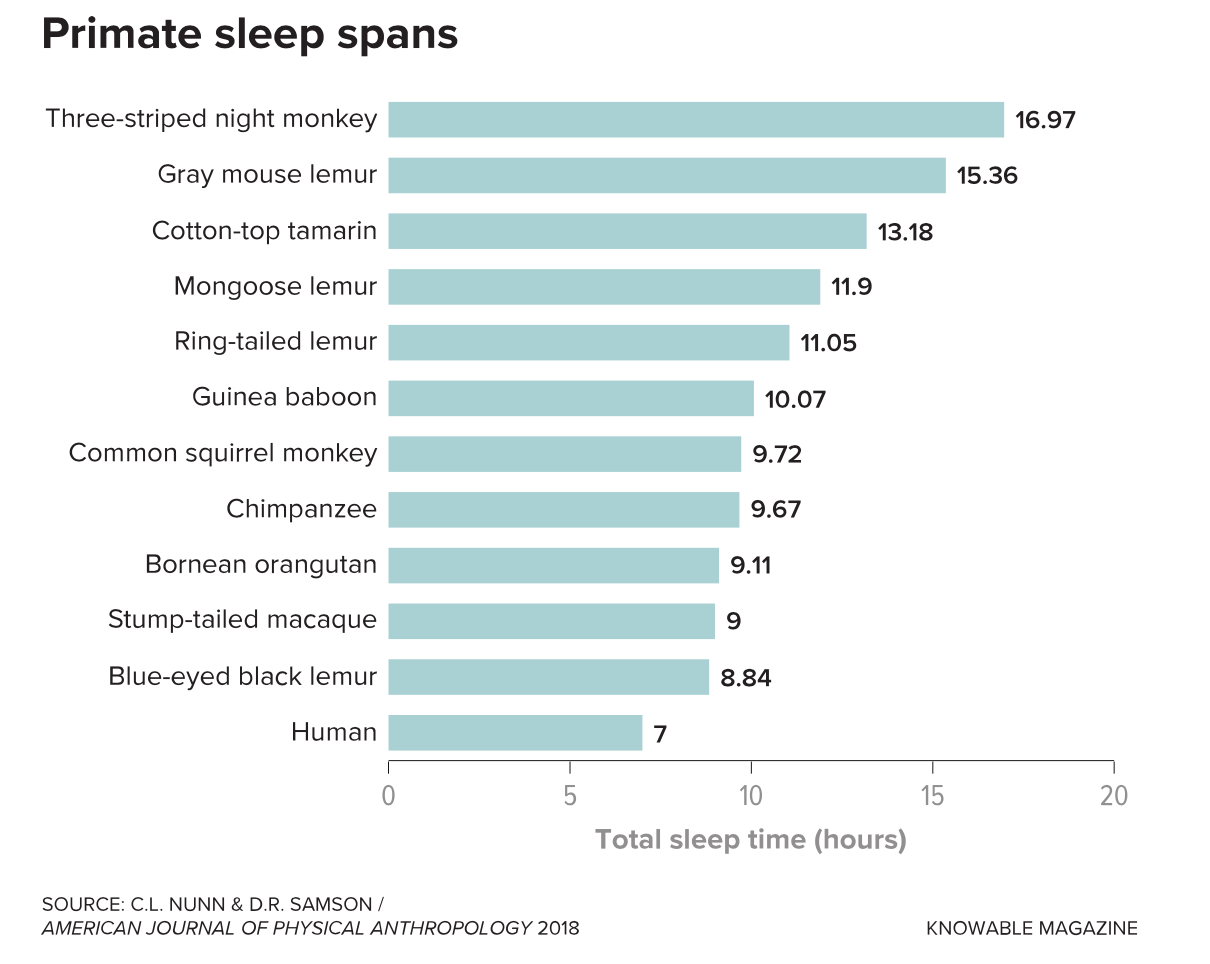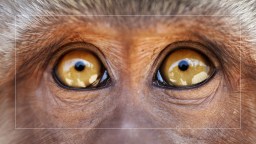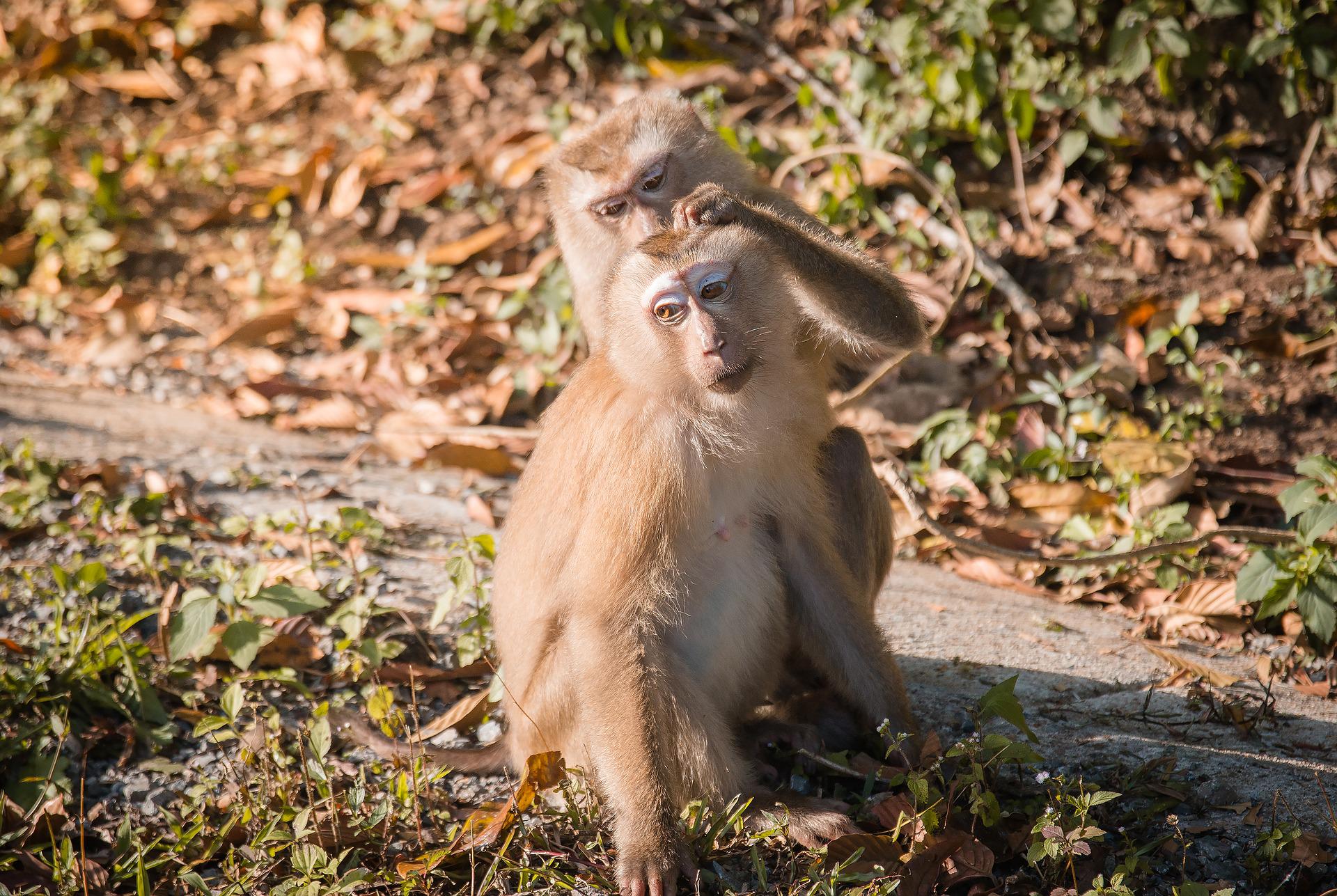Why do people sleep less than their primate relatives?

On dry nights, the San hunter-gatherers of Namibia often sleep under the stars. They have no electric lights or new Netflix releases keeping them awake. Yet when they rise in the morning, they haven’t gotten any more hours of sleep than a typical Western city-dweller who stayed up doom-scrolling on their smartphone.
Research has shown that people in non-industrial societies — the closest thing to the kind of setting our species evolved in — average less than seven hours a night, says evolutionary anthropologist David Samson at the University of Toronto Mississauga. That’s a surprising number when you consider our closest animal relatives. Humans sleep less than any ape, monkey or lemur that scientists have studied. Chimps sleep around 9.5 hours out of every 24. Cotton-top tamarins sleep around 13. Three-striped night monkeys are technically nocturnal, though really, they’re hardly ever awake — they sleep for 17 hours a day.
Samson calls this discrepancy the human sleep paradox. “How is this possible, that we’re sleeping the least out of any primate?” he says. Sleep is known to be important for our memory, immune function and other aspects of health. A predictive model of primate sleep based on factors such as body mass, brain size and diet concluded that humans ought to sleep about 9.5 hours out of every 24, not seven. “Something weird is going on,” Samson says.
Research by Samson and others in primates and non-industrial human populations has revealed the various ways that human sleep is unusual. We spend fewer hours asleep than our nearest relatives, and more of our night in the phase of sleep known as rapid eye movement, or REM. The reasons for our strange sleep habits are still up for debate but can likely be found in the story of how we became human.

From canopy bed to snail’s shell
Millions of years ago, our ancestors lived, and probably slept, in trees. Today’s chimpanzees and other great apes still sleep in temporary tree beds or platforms. They bend or break branches to create a bowl shape, which they may line with leafy twigs. (Apes such as gorillas sometimes also build beds on the ground.)
Our ancestors transitioned out of the trees to live on the ground, and at some point started sleeping there too. This meant giving up all the perks of arboreal sleep, including relative safety from predators like lions.
Fossils of our ancestors don’t reveal how well-rested they were. So to learn about how ancient humans slept, anthropologists study the best proxy they have: contemporary non-industrial societies.
“It’s an amazing honor and opportunity to work with these communities,” says Samson, who has worked with the Hadza hunter-gatherers of Tanzania, as well as with various groups in Madagascar, Guatemala and elsewhere. Study participants generally wear a device called an Actiwatch, which is similar to a Fitbit with an added light sensor, to record their sleep patterns.
Gandhi Yetish, a human evolutionary ecologist and anthropologist at the University of California, Los Angeles, has also spent time with the Hadza, as well as the Tsimane in Bolivia and the San in Namibia. In a 2015 paper, he assessed sleep across all three groups and found that they averaged between only 5.7 and 7.1 hours.
Humans, then, seem to have evolved to need less sleep than our primate relatives. Samson showed in a 2018 analysis that we did this by lopping off non-REM time. REM is the sleep phase most associated with vivid dreaming. That means, assuming other primates dream similarly, we may spend a larger proportion of our night dreaming than they do. We’re also flexible about when we get those hours of shut-eye.
To tie together the story of how human sleep evolved, Samson laid out what he calls his social sleep hypothesis in the 2021 Annual Review of Anthropology. He thinks the evolution of human sleep is a story about safety — specifically, safety in numbers. Brief, flexibly timed REM-dense sleep likely evolved because of the threat of predation when humans began sleeping on the ground, Samson says. And he thinks another key to sleeping safely on land was snoozing in a group.
“We should think of early human camps and bands as like a snail’s shell,” he says. Groups of humans may have shared simple shelters. A fire might have kept people warm and bugs away. Some group members could sleep while others kept watch.
“Within the safety of this social shell, you could come back and catch a nap at any time,” Samson imagines. (He and Yetish differ, however, on the prevalence of naps in today’s non-industrial groups. Samson reports frequent napping among the Hadza and a population in Madagascar. Yetish says that, based on his own experiences in the field, napping is infrequent.)
Samson also thinks these sleep shells would have facilitated our ancient ancestors’ journey out of Africa and into colder climates. In this way, he sees sleep as a crucial subplot in the story of human evolution.
As special as we seem?
It makes sense that the threat of predators may have led humans to sleep less than tree-living primates, says Isabella Capellini, an evolutionary ecologist at Queen’s University Belfast in Northern Ireland. In a 2008 study, she and her colleagues found that mammals at greater risk of predation sleep less, on average.
But Capellini isn’t sure that human sleep is as different from that of other primates as it seems. She points out that existing data about sleep in primates come from captive animals. “We still don’t know much about how animals sleep in the wild,” she says.
In a zoo or lab, animals might sleep less than is natural, because of stress. Or they might sleep more, Capellini says, “just because animals are that bored.” And the standard laboratory conditions — 12 hours of light, 12 hours of dark — might not match what an animal experiences in nature throughout the year.
Neuroscientist Niels Rattenborg, who studies bird sleep at the Max Planck Institute for Ornithology in Germany, agrees that Samson’s narrative about the evolution of human sleep is interesting. But, he says, “I think it depends a lot on whether we have measured sleep in other primates accurately.”
And there’s reason to suspect we haven’t. In a 2008 study, Rattenborg and colleagues attached EEG devices to three wild sloths and found that the animals slept about 9.5 hours per day. An earlier study of captive sloths, on the other hand, had recorded nearly 16 daily hours of sleep.
Having data from more wild animals would help sleep researchers. “But it’s technically challenging to do this,” Rattenborg says. “Although sloths were compliant with the procedure, I have a feeling primates would spend a lot of time trying to take the equipment off.”
If scientists had a clearer picture of primate sleep in the wild, it might turn out that human sleep isn’t as exceptionally short as it seems. “Every time there is a claim that humans are special about something, once we start having more data, we realize they’re not that special,” Capellini says.
Fireside chats
Yetish, who studies sleep in small-scale societies, has collaborated with Samson on research. “I do think that social sleep, as he describes it, is a solution to the problem of maintaining safety at night,” Yetish says. However, he adds, “I don’t think it’s the only solution.”
He notes that the Tsimane sometimes have walls on their houses, for example, which would provide some safety without a human lookout. And Yetish has had people in the groups he studies tell him in the morning exactly which animals they heard during the night. Sounds wake most people at night, offering another possible layer of protection.
Sleeping in groups, predator threats or not, is also a natural extension of the way that people in small-scale societies live during the day, Yetish says. “In my opinion, people are almost never alone in these types of communities.”
Yetish describes a typical evening with the Tsimane: After spending the day working on various tasks, a group comes together around a fire while food is cooked. They share a meal, then linger by the fire in the dark. Children and mothers gradually move away to sleep, while others stay awake, talking and telling stories.
And so Yetish suggests that ancient humans may have traded some hours of sleep for sharing information and culture around a dwindling fire. “You’ve suddenly made these darkness hours quite productive,” he says. Our ancestors may have compressed their sleep into a shorter period because they had more important things to do in the evenings than rest.
Unsatisfied sleepers
How much we sleep is a different question, of course, from how much we wish we slept. Samson and others asked Hadza study participants how they felt about their own sleep. Out of 37 people, 35 said they slept “just enough,” the team reported in 2017. The average amount they slept in that study was about 6.25 hours a night. But they awoke frequently, needing more than 9 hours in bed to get those 6.25 hours of shut-eye.
By contrast, a 2016 study of almost 500 people in Chicago found they spent nearly all of their time in bed actually asleep, and got at least as much total sleep as the Hadza. Yet almost 87 percent of respondents in a 2020 survey of US adults said that on at least one day per week, they didn’t feel rested.
Why not? Samson and Yetish say our sleep problems may have to do with stress or out-of-whack circadian rhythms. Or maybe we’re missing the crowd we evolved to sleep with, Samson says. When we struggle to get sleep, we could be experiencing a mismatch between how we evolved and how we live now. “Basically we’re isolated, and this might be influencing our sleep,” he says.
A better understanding of how human sleep evolved could help people rest better, Samson says, or help them feel better about the rest they already get.
“A lot of people in the global North and the West like to problematize their sleep,” he says. But maybe insomnia, for example, is really hypervigilance — an evolutionary superpower. “Likely that was really adaptive when our ancestors were sleeping in the savannah.”
Yetish says that studying sleep in small-scale societies has “completely” changed his own perspective.
“There’s a lot of conscious effort and attention put on sleep in the West that is not the same in these environments,” he says. “People are not trying to sleep a certain amount. They just sleep.”
This article originally appeared in Knowable Magazine, a nonprofit publication dedicated to making scientific knowledge accessible to all. Sign up for Knowable Magazine’s newsletter.






